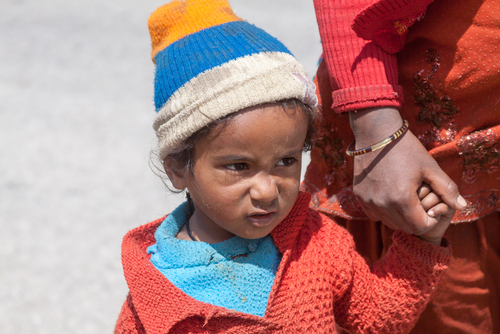Poll-bound Uttarakhand has rich people - and children with poor health
IANS Feb 09, 2017
It ranks number six in per capita income, but relatively prosperous Uttarakhand does worse than many poorer states with its infant mortality rate (IMR), ranking 18th among 29 states, an indication of its indifferent health as it prepares to choose a new government on February 15.

Although the maternal mortality ratio has improved, child-health indicators, collectively, a major bellwether of a state's healthcare system, do not match Uttarakhand's relative prosperity, according to an Observer Research Foundation analysis. Highlights:
* Over 10 years to 2015-16, the IMR has stagnated at 40 deaths per 1,000 live births; it was 42 in 2005-06, worse than poorer states, such as Himachal Pradesh.
* A fifth of all children below five years of age are wasted -- low weight for height -- and there was no improvement over a decade to 20 percent wasted.
* A quarter of newborn babies are underweight, compared to 36 per cent and 28 per cent in Rajasthan and Jharkhand, respectively, for the year 2012-13.
* The proportion of stunted -- low height for age -- children declined relatively faster, from 44 per cent to 34 per cent in a decade to 2015-16, compared to India's improvement from 48 per cent to 39 per cent. Proportion of underweight -- low weight for age -- children reduced from 38 per cent to 27 per cent in the decade.
With 10 million people -- or less than half as many as Delhi with an area 36 times as large -- Uttarakhand clearly struggles to offer adequate healthcare and get doctors and other medical professionals to many far-flung villages.
Community Health Centres (CHCs) -- the second-rung of the public health system -- are 83 per cent short of specialists required to handle emergencies and 50 per cent short of nursing staff. No more than 68 per cent of Primary Health Centres (PHCs), the frontline of the basic healthcare system, work as they are supposed to 24×7, according to data from the District Level Household and Facility Survey (DLHS-4).
The IMR of rural areas around Haridwar -- Uttarakhand's second-largest city -- is 70 (2012-13), worse than the average for India's worst statewide IMR of (68) recorded in 2012-13 in Uttar Pradesh. Rural Haridwar's IMR is also worse than many of the poorest African nations.
Uttarakhand doubled the number of institutional births to 69 per cent in the decade ending 2015-16, with about two-thirds in public health facilities. But private healthcare varies across districts, according to 2012-13 data, the latest available, from the Annual Health Survey (AHS) 2012-13.
Haridwar is the only district where fewer babies are delivered by public healthcare than private. There is scarce private healthcare in the hills, where IMR rates are lowest across Uttarakhand. The hill districts of Rudraprayag, Pithoragarh and Almora have the fewest recorded deaths of infants, although healthcare is hard to reach, public or private. They still do better than districts with better access to private healthcare.
According to the Clinical, Anthropometric and Biochemical Survey-2014, Haridwar's high IMR also appears to be associated with its stunting rate of 52 per cent in children under five -- comparable to IMR of 23 in Pithoragarh with lowest proportion (22 per cent) of children under five stunted.
Haridwar may be an outlier, but Uttarakhand, in general, has experienced slow reductions in child undernutrition, as indicated in the two National Family Health Surveys set 10 years apart.
According to the National Family Health Survey-2015-16, a third of children under five are stunted, with this rate -- comparable to some poorer states, such as Assam (36 per cent) and Chhattisgarh (38 per cent) -- varying widely across districts, from 52 per cent in Haridwar to 22 per cent in mountainous Pithoragarh, where only four per cent of babies are delivered at public healthcare facilities.
The fact that a quarter of newborn babies are underweight reflects long-term malnutrition among females (aged 18-59) measured as BMI less than 18.5. It is also reasonably clear that mothers and their children in Uttarakhand do not receive the medical attention they require from the public healthcare system.
Apart from high IMR and slow reduction of malnutrition the state also now faces a dwindling sex ratio.
In the decade to 2015-16, the sex ratio at birth improved for rural Uttarakhand but declined for urban areas. The state average is 888 females per 1,000 males (2015-16) at birth, with wide disparities between Urban (817) and Rural (924).
Uttarakhand, however, shows improvement in ensuring legal age at marriage for women is observed. The proportion of women aged 20-24 married before the legal age of marriage (18) declined over a decade, from 23 per cent to 14 per cent in 2015-16, according to NFHS-4 data.
Early marriage followed by early pregnancy is a major cause of poor maternal and child health in India. Uttarakhand has made reasonable progress on this score, as women aged 15-19 either pregnant or with a live birth at the time of the survey has halved between 2005 and 2015. This means that even if married early, fewer women were bearing children before age 19.
With better healthcare infrastructure and funding, Uttarakhand -- which has improved institutional deliveries of babies -- could further reduce infant and baby deaths.
Uttarakhand does need to allocate more money to healthcare. So far, its special-category status -- meaning devolution of more central assistance in development -- has helped secure greater central funding, but with changing Centre-state finances, the state will need to find innovative and cost-effective public-health financing.
-
Exclusive Write-ups & Webinars by KOLs
-
Daily Quiz by specialty
-
Paid Market Research Surveys
-
Case discussions, News & Journals' summaries